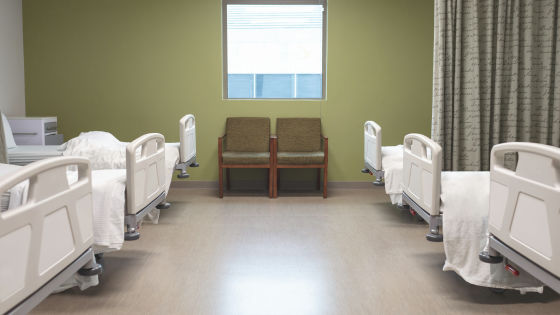Claims that “hospital design” should be reviewed due to the spread of new coronavirus infection

The number of people infected with the new coronavirus is increasing day by day, and the lack of rooms and beds is a serious problem. With plans to replace hospital rooms in hotels and convention centers to accommodate patients, many healthcare professionals and architects are preparing to prepare for the lack of rooms due to a pandemic. We suggest revising the hospital design.
How COVID-19 Could Inform the Future of Hospital Design | Innovation | Smithsonian Magazine
It has been pointed out that a problem with conventional hospitals is that they lack the flexibility to respond to sudden surges in the number of patients. In fact, with the epidemic of the new coronavirus, many hospitals lack not only emergency rooms and intensive care units to treat severely infected people, but also space to test mildly infected people.

`` We have beds not only in the lobby of our hospital, but also in our conference rooms and cafeterias, '' said Terry Lynam, chief spokeswoman for Northwell
'What you need to understand is that even if you have a patient in a convention center, you can't say that you've cleared all compliance and air conditioning issues,' said Construction Consultant Vice President of Organizational Development at HKS. Said Stan Shelton. Most of the temporary sickrooms, which have extra beds in places that are not originally sickrooms, are used for the isolation and medical care of mildly infected persons. However, air conditioning systems such as heating and ventilation often do not meet hospital standards.
It should be noted that not all facilities are suitable for hospital rooms, and some facilities such as sports arenas and hotels are equipped with air-conditioning facilities that are similar to those in hospitals, and as treatment facilities for mildly infected persons It can function.

Many hospitals follow the design of the
The rooms in the Nightingale ward have windows to let in fresh air and sunlight, and the beds are separated by more than 6 feet (about 1.8 meters), requiring a high standard of cleanliness. The hospital system, devised by Nightingale, worked by the medical staff maintaining good hygiene and careful patient care. However, the 1918 flu pandemic revealed the risk of managing many patients in one room. After that, in order to minimize the spread of infection, hospitals have been introducing 'private rooms with only one bed' for decades.
Even so, a room that manages multiple patients in one room, such as the Nightingale ward, 'is effective in treating mild new coronavirus-infected individuals who have few problems with group isolation,' said HKS. Development Director Jenny Evans said.

The lack of beds due to the epidemic of the new coronavirus in the United States is said to be a by-product of reforms focused on cost reduction by the US government and private medical institutions. In addition, it is thought that one of the reasons is that people are now able to receive medical services at facilities other than hospitals near their homes, such as clinics and pharmacies.
“By prioritizing treatment efficiency, patients spend less time in hospitals and fewer rooms and beds are needed. Of course, this is a good change, but hospitals are a social responsibility. It's not always a good change when it comes to achieving that, 'says Randy Gillott, design director for

Gensler has been supporting the expansion of emergency beds in hospitals in order to resolve the lack of beds due to the new coronavirus. Given the lack of beds, Gensler proposes a design that allows hospitals to temporarily expand capacity in an emergency. The Lambam Hospital in Israel, mentioned as an example, is designed to deploy 2000 beds in an underground car park in an emergency. The Rush University Medical Center in Chicago, USA is fully equipped to operate all hospital rooms as an operating room or an emergency room, and is also designed to allow patients' family accommodations to serve as patient rooms in an emergency. I will.
In addition to the flexible capacity of hospitals, the need for new equipment is being emphasized due to the spread of new coronavirus infections. For example, it is required to design the hospital room with antibacterial materials such as copper in order to control the lighting and temperature inside the patient room in a touch-free manner and to reduce the risk of infection. In addition, some hospitals have abolished the window cloth curtains, which are prone to carrying viruses, and installed smart glass windows that can be switched between translucent and opaque and are easy to clean.
Diana Anderson, a medical researcher at the University of California and the founder of healthcare design consultancy Dochitect , said that many patients and healthcare professionals are suffering from the loneliness and emotional distress of isolation. He says that incorporating technologies such as calling and VR headsets can help keep you connected with friends and family.

“Because of the lack of beds, health care professionals have assigned not only their rest space, but also a nap area to their beds. In particular, nurses and doctors go home to protect their families from infection. Given the current situation of sleeping in cars and other vehicles, there is an increasing need to provide healthcare professionals with a place to rest, 'Anderson said.
Rest spaces for health professionals are usually a lesser priority in discussions in hospital design, according to Anderson. Anderson, who is both a doctor and an architect, believes that the rest space is a very important place in both the general hospital and the hospital that will be newly designed.
'I think the experience of health care professionals is stressful. We build an environment where they can have time to rest, connect with loved ones, meditate and spend time for themselves. We have to be able to spend and spend, ”Anderson insists.
Related Posts:
in Note, Posted by darkhorse_log







